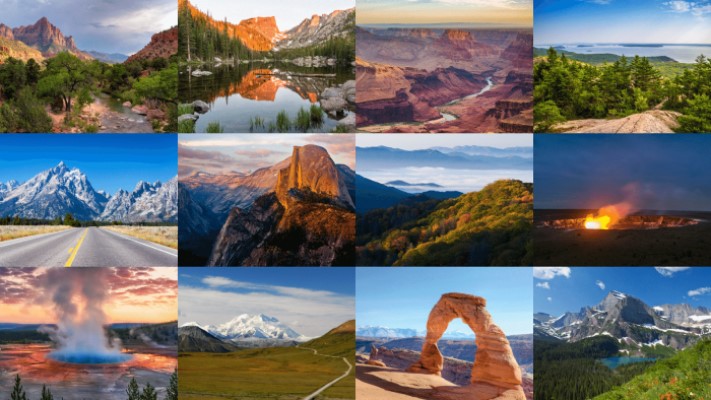Destinations
List of All 58 National Parks in the US: A Comprehensive Guide

The United States is blessed with an abundance of natural beauty and a vast wilderness that is home to a diverse range of flora and fauna. To preserve and protect these natural wonders, the US government has established 58 national parks across the country. These national parks offer visitors a chance to experience the raw beauty of nature and explore its wonders up close. From towering mountains to arid deserts, lush forests to pristine beaches, each national park has its unique charm that is waiting to be discovered.
The List of All 58 National Parks in the US
Here is a list of all 58 national parks in the United States, arranged alphabetically:
- Acadia National Park
- American Samoa National Park
- Arches National Park
- Badlands National Park
- Big Bend National Park
- Biscayne National Park
- Black Canyon of the Gunnison National Park
- Bryce Canyon National Park
- Canyonlands National Park
- Capitol Reef National Park
- Carlsbad Caverns National Park
- Channel Islands National Park
- Congaree National Park
- Crater Lake National Park
- Cuyahoga Valley National Park
- Death Valley National Park
- Denali National Park and Preserve
- Dry Tortugas National Park
- Everglades National Park
- Gates of the Arctic National Park and Preserve
- Gateway Arch National Park
- Glacier Bay National Park and Preserve
- Glacier National Park
- Grand Canyon National Park
- Grand Teton National Park
- Great Basin National Park
- Great Sand Dunes National Park and Preserve
- Great Smoky Mountains National Park
- Guadalupe Mountains National Park
- Haleakalā National Park
- Hawaii Volcanoes National Park
- Hot Springs National Park
- Isle Royale National Park
- Joshua Tree National Park
- Katmai National Park and Preserve
- Kenai Fjords National Park
- Kings Canyon National Park
- Kobuk Valley National Park
- Lake Clark National Park and Preserve
- Lassen Volcanic National Park
- Mammoth Cave National Park
- Mesa Verde National Park
- Mount Rainier National Park
- North Cascades National Park
- Olympic National Park
- Petrified Forest National Park
- Pinnacles National Park
- Redwood National and State Parks
- Rocky Mountain National Park
- Saguaro National Park
- Sequoia National Park
- Shenandoah National Park
- Theodore Roosevelt National Park
- Virgin Islands National Park
- Voyageurs National Park
- Wind Cave National Park
- Wrangell-St. Elias National Park and Preserve
- Yellowstone National Park
1. Acadia National Park
Located in Maine, this national park is renowned for its stunning coastal scenery, including rocky beaches, verdant forests, and a labyrinth of waterways.
2. American Samoa National Park
This national park is located on the American Samoa Islands and is famous for its pristine coral reefs, ancient volcanic peaks, and tropical rainforests.
3. Arches National Park
Located in Utah, Arches National Park is home to over 2,000 natural sandstone arches and numerous other geological formations, making it a popular destination for rock climbing and hiking enthusiasts.
4. Badlands National Park
The Badlands National Park in South Dakota is a stark and striking landscape of eroded rock formations, mixed-grass prairies, and one of the richest fossil beds in the world.
5. Big Bend National Park
Located in Texas, Big Bend National Park is home to the Chisos Mountains, the Rio Grande, and a vast desert wilderness that is rich in wildlife and diverse landscapes.
6. Biscayne National Park
This national park in Florida is famous for its crystal-clear waters, colorful coral reefs, and a diverse array of marine life, including dolphins, manatees, and sea turtles.
7. Black Canyon of the Gunnison National Park
Located in Colorado, Black Canyon of the Gunnison National Park is a rugged and dramatic landscape of steep cliffs, narrow canyons, and the raging Gunnison River.
8. Bryce Canyon National Park
This national park in Utah is famous for its breathtaking hoodoos, which are spires of rock that have been eroded by wind and water over millions of years.
9. Canyonlands National Park
Canyonlands National Park in Utah is a vast wilderness of canyons, mesas, and arches that has been sculpted by the mighty Colorado River and its tributaries.
10. Capitol Reef National Park
Located in Utah, Capitol Reef National Park is a geological wonderland of towering cliffs, deep canyons, and natural arches that are millions of years old.
11. Carlsbad Caverns National Park
Carlsbad Caverns National Park is a stunning and massive underground cave system in southern New Mexico. The park was established in 1930, and its main attraction is the Carlsbad Cavern, a series of chambers and passages that stretch for over 30 miles. Visitors to the park can explore the caves and witness the stunning rock formations that have been created over millions of years.
The park is also home to a diverse array of wildlife, including bats, cave swallows, and the rare and elusive mountain lion. The surrounding landscape is characterized by desert scrub, grasslands, and riparian areas, and visitors can enjoy hiking, camping, and other outdoor activities in addition to exploring the caves.
If you’re planning a visit to Carlsbad Caverns National Park, here are some key things to know:
- The Carlsbad Cavern is the park’s main attraction, and visitors can access the cave via a series of trails and elevators. There are several different tours available, ranging from self-guided tours to more extensive guided tours that explore deeper into the cave system.
- The park is open year-round, but the cave tours are subject to seasonal closures and may have limited availability during certain times of the year. Be sure to check the park’s website for the latest information on tour schedules and availability.
- In addition to the cave tours, there are plenty of other outdoor activities to enjoy in the park. The park’s hiking trails range from easy walks to more challenging treks, and there are also opportunities for camping, birdwatching, and stargazing.
- If you’re interested in exploring the caves more extensively, the park offers several spelunking tours that take visitors off the beaten path and into more remote sections of the cave system. These tours require advance reservations and have limited availability, so be sure to plan ahead if you’re interested.
- The park is home to a diverse array of wildlife, including many species that are adapted to the unique cave environment. Visitors should be respectful of the wildlife and follow park guidelines for viewing and interacting with animals.
- Finally, be sure to come prepared for your visit to Carlsbad Caverns National Park. The desert climate can be hot and dry, so be sure to bring plenty of water and sunscreen. You’ll also want to wear sturdy shoes with good traction for exploring the caves and hiking trails.
Overall, Carlsbad Caverns National Park is a unique and fascinating destination that offers something for everyone. Whether you’re interested in exploring the underground caves or enjoying the park’s outdoor activities, a visit to Carlsbad Caverns is sure to be a memorable experience.
12. Channel Islands National Park
Channel Islands National Park is located in the state of California and is comprised of five of the eight Channel Islands. This park is unique because it protects a wealth of natural and cultural resources, including over 2,000 plant and animal species, archeological sites, and historic buildings.
Visitors to Channel Islands National Park can participate in a variety of recreational activities, including hiking, camping, kayaking, and wildlife watching. One of the most popular activities on the islands is snorkeling and scuba diving. The crystal-clear waters surrounding the islands are home to a variety of colorful fish, kelp forests, and even shipwrecks.
The Channel Islands were once home to the Chumash people, and visitors to the park can explore the remains of their ancient villages, which date back over 10,000 years. The park also contains a number of historic lighthouses and military installations, which offer visitors a glimpse into the region’s rich maritime history.
If you’re planning a trip to Channel Islands National Park, here are some important things to keep in mind:
- The islands are only accessible by boat or plane, so plan your transportation accordingly.
- The weather can be unpredictable, so bring layers and be prepared for both sun and rain.
- The islands are home to a number of endemic species, so be sure to respect the natural environment and follow all park rules and regulations.
- If you plan to camp on the islands, be sure to make reservations in advance, as campsites fill up quickly.
- Finally, be sure to bring plenty of water and snacks, as there are no stores or restaurants on the islands.
In conclusion, Channel Islands National Park is a unique and fascinating destination that offers visitors the chance to explore a diverse array of natural and cultural resources. Whether you’re interested in hiking, camping, snorkeling, or simply soaking up the natural beauty of the islands, this park has something to offer everyone. So why not plan a visit and experience it for yourself?
13. Congaree National Park
Nestled in the heart of South Carolina lies Congaree National Park, a true hidden gem. It may be one of the smallest national parks in the United States, but what it lacks in size, it more than makes up for in natural beauty and biodiversity. Spanning over 27,000 acres, this park is home to some of the tallest and oldest trees in the country.
The park’s main feature is the Congaree River, which flows through the park and provides a habitat for a diverse range of wildlife. Visitors can explore the river by canoe, kayak or paddleboard. Alternatively, there are several hiking trails that lead through the park’s forests, swamps and wetlands. The trails vary in length and difficulty, making it easy for visitors of all ages and fitness levels to enjoy the natural beauty of the park.
One of the most popular trails is the Boardwalk Trail, which leads visitors on a 2.4-mile walk through a towering forest of bald cypress trees. These trees can grow up to 100 feet tall and are adapted to survive in wetland environments. Along the way, visitors can spot a variety of wildlife, including otters, turtles, and many different species of birds.
The park’s biodiversity is truly impressive. It is home to over 20 different species of amphibians, including the rare and endangered dusky gopher frog. There are also over 160 species of birds, including the prothonotary warbler, a bright yellow bird that is a symbol of the park. In addition, the park is home to a number of mammals, including deer, raccoons, and even the occasional black bear.
While the park’s natural beauty is its main attraction, there are also several cultural sites of interest. The park was once home to Native American tribes, who used the Congaree River for transportation and fishing. Visitors can learn about the history and culture of these tribes at the Harry Hampton Visitor Center.
If you’re looking for a unique and beautiful outdoor experience, Congaree National Park is not to be missed. With its towering trees, diverse wildlife, and peaceful river, it is a true natural oasis in the heart of South Carolina. Don’t forget to pack your camera and plenty of bug spray!
14. Crater Lake National Park
Crater Lake National Park is located in southern Oregon and is famous for its deep blue lake, which is the main attraction of the park. The lake is situated in a volcanic crater and is said to be one of the clearest and cleanest lakes in the world. The park’s rugged mountains, old-growth forests, and diverse wildlife make it a popular destination for hiking, camping, and wildlife viewing.
Here are some interesting facts about Crater Lake National Park:
- Crater Lake is the deepest lake in the United States, with a depth of 1,949 feet (594 meters).
- The lake was formed around 7,700 years ago after the collapse of a volcano known as Mount Mazama.
- Crater Lake is famous for its blue color, which is due to its incredible clarity and depth. The lake’s intense blue color comes from the way sunlight is absorbed and scattered by the water molecules.
- Crater Lake National Park is home to a diverse range of wildlife, including black bears, mountain lions, elk, and many bird species.
- The park has over 90 miles (145 kilometers) of hiking trails, ranging from easy nature walks to challenging summit climbs.
If you’re planning a visit to Crater Lake National Park, here are some must-see attractions:
- Crater Lake: Of course, the main attraction of the park is the stunningly beautiful Crater Lake itself. You can take a boat tour of the lake or hike around the rim to get different views of the lake.
- Cleetwood Cove Trail: This steep trail takes you down to the lake’s edge, where you can swim or kayak in the crystal-clear waters.
- Wizard Island: This small island in the middle of Crater Lake is a must-see for hikers and nature lovers. You can take a boat tour to the island and then hike to the top for stunning views of the surrounding area.
- Rim Drive: This 33-mile (53-kilometer) scenic drive takes you around the entire rim of Crater Lake and offers breathtaking views of the lake and the surrounding mountains.
If you’re looking for a unique and stunning natural wonder to explore, then Crater Lake National Park should definitely be on your list of all 58 national parks in the US to visit.
Next on our list is Cuyahoga Valley National Park in Ohio. Let’s take a closer look.
15. Cuyahoga Valley National Park
Cuyahoga Valley National Park is located in Ohio, USA. It covers an area of 33,000 acres and is the only national park in the state of Ohio. The park was established in 2000 and offers visitors a wide range of recreational activities and natural attractions.
Hiking is a popular activity at Cuyahoga Valley National Park, with over 125 miles of trails to explore. The park also has several waterfalls, including the 65-foot Brandywine Falls, which is a popular spot for photographers. For those who prefer to explore the park on two wheels, there is a 20-mile bike trail that runs through the park, offering stunning views of the Cuyahoga River.
Cuyahoga Valley National Park is home to a variety of wildlife, including white-tailed deer, coyotes, beavers, and a wide range of bird species. The park is also home to several historical sites, including the Hale Farm and Village, which offers visitors a glimpse into life in the 19th century.
If you’re planning a visit to Cuyahoga Valley National Park, here are a few things you should know:
- The park is open year-round, but some facilities may be closed during the winter months.
- The park offers a variety of ranger-led programs, including guided hikes, bike tours, and campfire programs.
- There are several campgrounds in the park, as well as several lodging options just outside the park boundaries.
- The park is located just a short drive from both Cleveland and Akron, making it a convenient day trip for those visiting either city.
In conclusion, Cuyahoga Valley National Park is a hidden gem in the heart of Ohio, offering visitors a chance to explore the beauty and diversity of the Midwest. Whether you’re an avid hiker, nature lover, or history buff, there is something for everyone at this unique national park. So, don’t miss the chance to add Cuyahoga Valley National Park to your list of all 58 national parks in the US!
16. Death Valley National Park
Death Valley National Park is one of the most unique and beautiful national parks in the United States. Located in California, it covers an area of over 3.4 million acres and is the largest national park in the contiguous United States. The park is known for its extreme weather conditions, stunning natural features, and diverse wildlife.
One of the most popular attractions in Death Valley National Park is Badwater Basin, which is the lowest point in North America. It sits at an elevation of 282 feet below sea level and is surrounded by salt flats, which create a beautiful, otherworldly landscape. Another popular attraction is Dante’s View, which offers visitors stunning views of the valley and the surrounding mountains.
In addition to its natural attractions, Death Valley National Park is also home to a variety of wildlife, including bighorn sheep, coyotes, and bobcats. The park is also home to several rare and endangered species, such as the desert tortoise and the Badwater snail.
If you’re planning a visit to Death Valley National Park, here are a few things you should know:
- The park is open year-round, but temperatures can reach over 100 degrees Fahrenheit in the summer months. It’s important to bring plenty of water and to stay hydrated.
- The park offers a variety of hiking trails, ranging from easy walks to strenuous hikes. Some of the most popular trails include the Golden Canyon Trail and the Telescope Peak Trail.
- There are several campgrounds in the park, as well as several lodging options just outside the park boundaries.
- The park is located a few hours from both Las Vegas and Los Angeles, making it a popular day trip for those visiting either city.
In conclusion, Death Valley National Park is a must-see destination for anyone visiting California or the Southwest. Its unique landscape, extreme weather conditions, and diverse wildlife make it a truly unforgettable experience. So, don’t miss the chance to add Death Valley National Park to your list of all 58 national parks in the US!
17. Denali National Park and Preserve
Denali National Park and Preserve is located in the interior region of Alaska, and it is one of the largest national parks in the United States, covering an area of 6 million acres. The park is named after the highest peak in North America, Denali, which stands at 20,310 feet above sea level. The park is home to a diverse range of wildlife, including grizzly bears, wolves, caribou, and moose, and it offers visitors a unique opportunity to experience the raw beauty of the Alaskan wilderness.
One of the most popular attractions in Denali National Park and Preserve is the Denali Park Road, which stretches for 92 miles and offers stunning views of the surrounding mountains and wildlife. The park road is closed to private vehicles, but visitors can take a bus tour to explore the park and learn about its history and geology.
Denali National Park and Preserve also offers a variety of hiking trails, ranging from easy walks to strenuous multi-day backpacking trips. The most popular trails include the Savage River Loop Trail, the Horseshoe Lake Trail, and the Mount Healy Overlook Trail.
If you’re planning a visit to Denali National Park and Preserve, here are a few things you should know:
- The park is only accessible by road, and it’s located about 240 miles north of Anchorage. Visitors can take a shuttle or tour bus from Anchorage or Fairbanks to reach the park.
- The park is open year-round, but the summer months (June through August) are the busiest and offer the most activities.
- The weather in Denali National Park and Preserve can be unpredictable, and visitors should be prepared for cold, wet, and windy conditions.
- There are several campgrounds in the park, as well as several lodging options just outside the park boundaries.
In conclusion, Denali National Park and Preserve is a must-see destination for anyone who wants to experience the raw beauty of the Alaskan wilderness. Its stunning landscapes, diverse wildlife, and challenging hiking trails make it a truly unforgettable experience, and it’s no wonder that it’s one of the most popular national parks in the United States. So, don’t miss the chance to add Denali National Park and Preserve to your list of all 58 national parks in the US!
18. Dry Tortugas National Park
Dry Tortugas National Park is located in the Gulf of Mexico, 70 miles west of Key West, Florida. It’s one of the most unique national parks in the US due to its remote location and pristine waters. The park covers almost 100 square miles, with the majority of its territory consisting of protected marine ecosystems.
Here is what you need to know about Dry Tortugas National Park:
Getting There: The only way to get to Dry Tortugas National Park is by seaplane or boat. There are no roads leading to the park, so it’s only accessible by water or air. Visitors can take a ferry or private charter from Key West, which takes approximately two and a half hours.
Activities: The park is best known for its crystal clear waters and coral reefs, which make it a popular destination for snorkeling, scuba diving, and fishing. Visitors can also explore the historic Fort Jefferson, which was built in the 19th century to protect the Gulf of Mexico. The park also offers camping, birdwatching, and hiking trails.
Wildlife: Dry Tortugas is home to a wide range of wildlife, including sea turtles, tropical fish, and a variety of bird species. The waters surrounding the park are also home to several shipwrecks that have become artificial reefs, providing a unique habitat for marine life.
Best Time to Visit: The best time to visit Dry Tortugas National Park is during the winter months, from December to March, when the weather is mild and the water is calm. Summer months can be hot and humid, with frequent thunderstorms.
Park Regulations: Dry Tortugas is a protected marine ecosystem, so visitors must abide by park regulations. Fishing is only allowed in certain areas, and a permit is required. Visitors are not allowed to take any natural or cultural resources from the park, including shells, sand, or artifacts.
Conclusion: If you’re looking for a unique national park experience, Dry Tortugas is definitely worth a visit. Its remote location and protected marine ecosystem make it an ideal destination for snorkeling, diving, and exploring the rich history of Fort Jefferson. Just remember to abide by park regulations and respect the natural beauty of this pristine environment.
19. Everglades National Park
Everglades National Park is a 1.5-million-acre wetland preserve in the southern part of Florida, United States. It is known for its diverse wildlife and unique ecosystem, and it is the largest tropical wilderness area in the country. The park is home to a wide range of plant and animal species, including several endangered species.
Everglades National Park is one of the most unique and fascinating parks in the United States. Located in southern Florida, this 1.5-million-acre wetland preserve is home to a vast array of plant and animal species, many of which are found nowhere else on Earth. The park is also an important area for conservation, as it protects a fragile ecosystem that has been threatened by human activities for decades. In this article, we will explore the highlights of Everglades National Park and discuss its efforts to preserve its remarkable ecosystem.
Exploring Everglades National Park The park offers many opportunities for visitors to explore its incredible ecosystem, including hiking, kayaking, and airboat tours.
Here are some of the must-see highlights of Everglades National Park:
- Shark Valley: This area of the park offers a 15-mile loop trail that winds through sawgrass prairies, cypress swamps, and mangrove forests. Visitors can rent bikes or take a guided tram tour to see the area’s diverse wildlife, including alligators, wading birds, and more.
- Anhinga Trail: This half-mile trail offers visitors a chance to see a variety of wildlife up close, including anhingas, herons, and alligators. The trail is wheelchair accessible and offers a unique view of the park’s freshwater sloughs.
- Flamingo: This area of the park is located on the southern tip of the Florida peninsula and offers a range of activities, including boat tours, fishing, and hiking. Visitors can also explore the area’s historic structures and learn about the park’s history.
- Gulf Coast Visitor Center: This visitor center is a great starting point for those new to the park, offering information on the park’s resources, history, and visitor activities. Visitors can also take a ranger-led tour or explore the nearby mangrove forests.
Conservation Efforts Everglades National Park is an important area for conservation, as it protects a fragile ecosystem that has been threatened by human activities for decades. The park is home to several endangered species, including the Florida panther and the American crocodile. In recent years, the park has undertaken a number of conservation efforts to preserve its unique ecosystem, including restoring natural water flow and reducing pollution. These efforts have helped to protect the park’s remarkable ecosystem and ensure that it will be preserved for future generations to enjoy.
FAQs
- What is the best time of year to visit Everglades National Park? The best time to visit the park is from December to April, when the weather is mild and dry. During the summer months, the park is hot and humid, with frequent thunderstorms.
- Can I camp in Everglades National Park? Yes, the park offers a variety of camping options, including drive-in and backcountry camping. Reservations are required for all campsites.
- What is the park’s entrance fee? The park entrance fee is $30 per vehicle, which is valid for 7 days. There are also annual passes available for $55.
Conclusion
Everglades National Park is a must-visit destination for nature lovers and anyone interested in learning about unique ecosystems.
20. Gates of the Arctic National Park and Preserve
Gates of the Arctic National Park and Preserve is a park located in Alaska, USA. It is known for its remote location, unspoiled natural beauty, and unique wildlife. The park is situated entirely north of the Arctic Circle and is one of the most isolated national parks in the United States. Despite its remoteness, Gates of the Arctic is a popular destination for adventure-seekers and nature lovers who are looking to experience the rugged and wild landscape of the Arctic.
Here are some interesting facts about Gates of the Arctic National Park and Preserve:
Location and Geography:
- Gates of the Arctic National Park and Preserve is located entirely north of the Arctic Circle in Alaska, USA.
- It covers an area of over 13,000 square miles and is the second-largest national park in the United States.
- The park is characterized by rugged mountain peaks, glaciers, deep river valleys, and wide expanses of tundra.
Wildlife:
- Gates of the Arctic is home to a variety of wildlife species, including grizzly bears, black bears, wolves, caribou, Dall sheep, and moose.
- It is also a popular destination for bird watchers, as the park is home to a wide variety of bird species, including bald eagles, gyrfalcons, and peregrine falcons.
Activities:
- Gates of the Arctic National Park and Preserve is a popular destination for adventure-seekers who are looking to experience the rugged and wild landscape of the Arctic.
- Popular activities in the park include backpacking, hiking, rafting, fishing, and hunting.
- The park has no established trails or roads, and visitors must rely on their own skills and equipment to explore the park.
Visiting the Park:
- Due to its remote location, visiting Gates of the Arctic National Park and Preserve can be challenging.
- The park is accessible only by foot, dog sled, or bush plane.
- Visitors to the park should be prepared for the harsh Arctic climate and should bring their own food, camping equipment, and survival gear.
In conclusion, Gates of the Arctic National Park and Preserve is a unique and remote destination that offers visitors the chance to experience the rugged and unspoiled beauty of the Arctic. From its stunning mountain peaks to its abundant wildlife, the park is a must-visit destination for anyone who loves adventure and the great outdoors.








